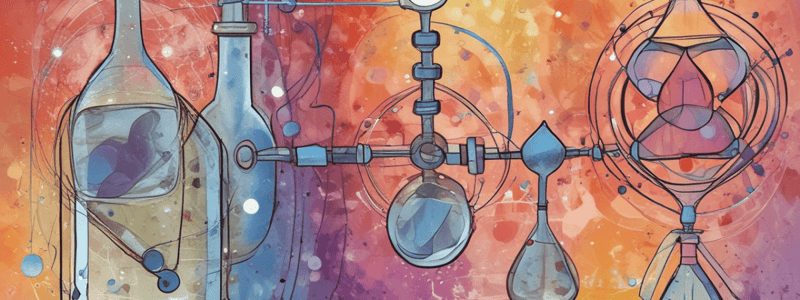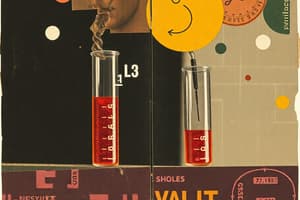Podcast
Questions and Answers
What is a characteristic of a reversible reaction?
What is a characteristic of a reversible reaction?
- It only involves the forward reaction
- It goes to completion
- It only occurs at high temperatures
- It can take place in either direction (correct)
What occurs when the Kc value is high?
What occurs when the Kc value is high?
- The forward reaction is predominant (correct)
- The rate of the forward reaction equals the rate of the reverse reaction
- Chemical equilibrium is not reached
- The backward reaction is predominant
What is the equilibrium constant of a reaction dependent on?
What is the equilibrium constant of a reaction dependent on?
- Only the concentration of the reactants
- The concentration of the reactants and products at a given temperature (correct)
- Only the concentration of the products
- The pressure of the system
What is the state of dynamic balance in which the rate of the forward reaction equals the rate of the reverse reaction?
What is the state of dynamic balance in which the rate of the forward reaction equals the rate of the reverse reaction?
What is the name of the process used in the industrial manufacture of ammonia?
What is the name of the process used in the industrial manufacture of ammonia?
What is the term for a reaction that goes to completion?
What is the term for a reaction that goes to completion?
What is the relationship between the rates of the forward and reverse reactions at chemical equilibrium?
What is the relationship between the rates of the forward and reverse reactions at chemical equilibrium?
What is a characteristic of the equilibrium constant (Kc)?
What is a characteristic of the equilibrium constant (Kc)?
What is the purpose of calculating Kc values?
What is the purpose of calculating Kc values?
What is the correct unit for the equilibrium constant (Kc)?
What is the correct unit for the equilibrium constant (Kc)?
What is the purpose of finding the initial moles of reactants?
What is the purpose of finding the initial moles of reactants?
Why is it necessary to calculate the moles of reactants at equilibrium?
Why is it necessary to calculate the moles of reactants at equilibrium?
What is the correct way to calculate the equilibrium concentrations of reactants and products?
What is the correct way to calculate the equilibrium concentrations of reactants and products?
Why is it necessary to check the values of x obtained from a quadratic equation?
Why is it necessary to check the values of x obtained from a quadratic equation?
What is the purpose of calculating the equilibrium concentrations of reactants and products?
What is the purpose of calculating the equilibrium concentrations of reactants and products?
Study Notes
Dynamic Equilibrium
- In a dynamic equilibrium, the concentration of reactants and products remains constant, but the forward and reverse reactions are still occurring.
- The rates of the forward and reverse reactions are equal at equilibrium.
Reversible Reactions
- Reversible reactions are reactions that can take place in either direction.
- Examples of reversible reactions include the formation of ammonia (N₂ + H₂ ⇌ NH₃) and the reaction between nitrogen and hydrogen.
Equilibrium Constant (Kc)
- The equilibrium constant (Kc) is a value that can be calculated by measuring the concentration of reactants and products at equilibrium.
- Kc is a constant value at a given temperature.
- The equilibrium constant expression is: Kc = [products] / [reactants]
- Kc values can be used to determine the direction of the reaction.
- When Kc is high, the forward reaction is predominant, and an abundance of product is produced.
- When Kc is low, the backward reaction is predominant, and not much product is produced.
Characteristics of Kc
- Kc is only relevant at equilibrium.
- Kc is altered only by a change in temperature.
- Kc is unaffected by changes in concentration of reactants or products.
- Kc may or may not have units.
Calculating Kc Values
- Examples of calculating Kc values include:
- Example 1: given the equilibrium concentrations, calculate the Kc value.
- Example 2: given the initial moles of reactants, calculate the Kc value.
- In some cases, a quadratic equation in x may result, and x is found using the quadratic formula.
Solving Equilibrium Problems
- To solve equilibrium problems, use the following steps:
- Write the equilibrium expression.
- Calculate the initial moles of reactants.
- Calculate the moles of reactants at equilibrium.
- Calculate the concentration of reactants at equilibrium.
- Substitute the values into the equilibrium expression to calculate Kc.
- Reject any negative values or values that are too large to be possible.
Studying That Suits You
Use AI to generate personalized quizzes and flashcards to suit your learning preferences.
Description
This quiz covers the concept of dynamic equilibrium, where the concentration of reactants and products remains constant, and reversible reactions, which can occur in both directions.




